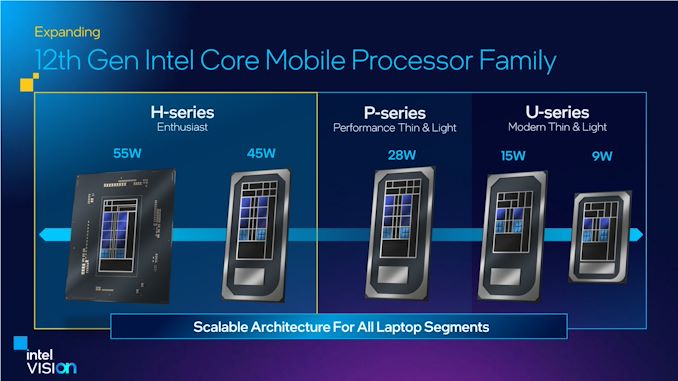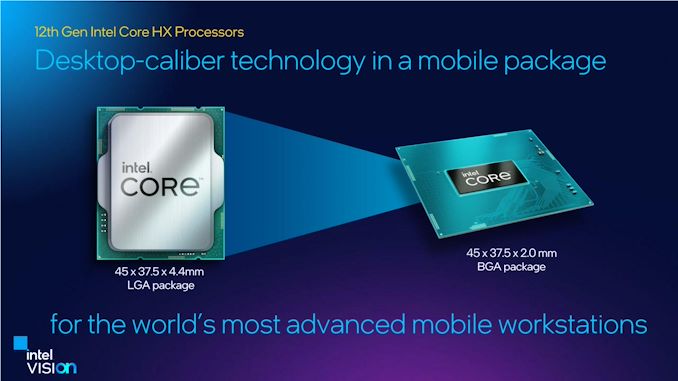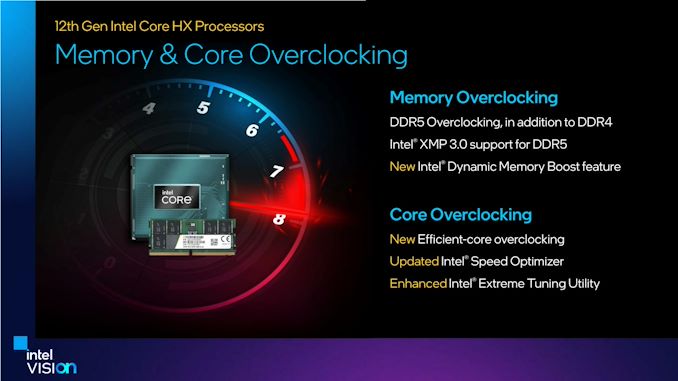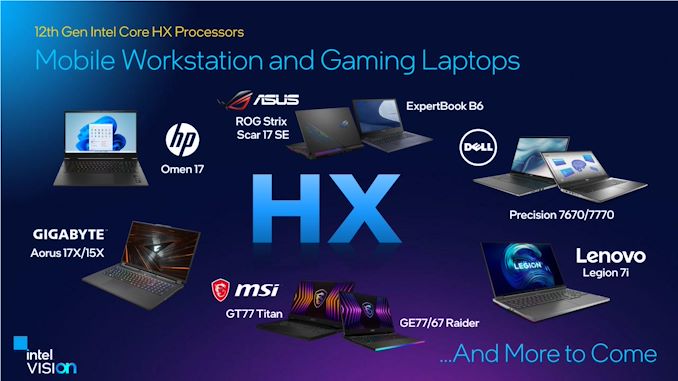Intel Launches Alder Lake-HX Series Core Processors: 55W and PCIe 5.0 For High-End Mobile
by Gavin Bonshor on May 10, 2022 11:00 AM ESTIntel today is announcing a new range of mobile 12th Gen Core family processors designed for enthusiast and desktop-replacement class laptops, the Alder Lake-HX series. Focusing on the more performance-driven high-end models, the Alder Lake HX series transfers its hybrid desktop design (ADL-S) into a thinner BGA package with up 16 cores (8P+8E) that's more suitable for mobile devices. And since it's based on that desktop hardware, Alder Lake-HX also brings with it some additional features that were previously limited to the desktop, such as support for PCIe 5.0, as well as a more desktop-like base TDP of 55 Watts.
In January of this year, Intel launched its first Alder Lake 12th Gen Core mobile processors, the Alder Lake-H family. In February, it then announced more for the lower-powered market through its Alder Lake-P and Alder Lake-U series with up to 14 cores with a mixture of its Performance (P) and Efficiency (E) cores. Intel has now officially launched the more premium of its 12th Gen Core series for mobile, the Alder Lake-HX series with up to 16 cores (8P+8E), and its new memory and core overclocking technology.
The latest in Intel's arsenal is designed for premium and enthusiast laptops, with seven new chips ranging from sixteen cores and twenty-four threads, all the way down to an eight-core and twelve thread SKU. According to Intel, the Alder Lake-HX series completes its Alder Lake mobile family, with options spanning many different markets using its hybrid 12th Gen Core architecture to deliver a significant range in mobile performance for enthusiasts, gamers, and workstation use cases.
Alder Lake-HX: Alder Lake-S Comes to Laptops
As previously mentioned, the crux of Alder Lake-HX's design is that Intel is porting their existing desktop Alder Lake-S design to mobile. This is not quite as surprising as it may first seem, since for years Intel's H and S series chips shared identical dies; but since Tiger Lake in 2021, desktop and mobile have become a bit more divorced. On the mobile side of matters, Intel has used a more laptop-centric design for its high performance mobile chips, incorporating features like Thunderbolt and higher performance Iris Plus/Xe integrated GPUs – and in the most recent generation, moving the PCH on-package as well.
The trade-off for this has been that Alder Lake-H shaved off some CPU functionally to accommodate the larger GPU and other laptop features. Which is why the top ADL-H SKUs only offer 6 P(erformance) cores, as opposed to 8 on desktop ADL-S.
Despite this bifurcation of desktop and mobile, it would seem that old habits die hard, and Intel is bringing its desktop Alder Lake die and associated platform to the mobile space as Alder Lake-HX. ADL-HX will allow Intel to offer mobile SKUs with 8 P cores, further improving their performance in MT workloads, and shoring up their competitiveness with AMD (whose designs only offer the equivalent of performance cores). It will also enable Intel to bring down a few of desktop Alder Lake's more unique features, such as PCIe 5.0 support, memory overclocking, and ADL-S's extensive I/O connectivity.
But this means that the ADL-HX loses some of the mobile magic of the rest of the mobile Alder Lake family. Integrated Thunderbolt 4 support is gone, and the integrated Xe-LP GPU goes from a rather capable 96 EU design down to a maximum of just 32 EUs, a configuration not suited for much above desktop work. ADL-HX also means the discrete chipset is back, as the design doesn't incorporate the on-chip PCH used by Intel's mobile parts.
The Intel Alder Lake-HX series also uses a very similar packaging size to its existing Alder Lake desktop processors. While the desktop models such as the Core i9-12900K use a socketed LGA package of 45 x 37.5 x 4.4 mm, the Alder Lake HX-series uses BGA packaging with a thinner 45 x 37.5 x 2.0 mm profile to enable it to effectively fit in more space restricting chassis such as laptops and notebooks. Intel states that this is designed to deliver desktop-like performance in a smaller and more mobile package. But this also means that ADL-HX can't pull off the kind of tightly packed, high-density laptop designs as the mobile-first chip designs.
All of which raises the question of why Intel is doing this, especially now, a third of the year after the launch of their original Alder Lake-H family. Ostensibly, it's for performance reasons, as Intel's top SKUs gain two more P cores out of the deal. So for desktop replacement-class laptops and other high-end devices that aren't making good use of ADL-H's mobile optimizations – such as by including a discrete GPU – they can essentially forgo them for more CPU performance. At the same time it gives Intel a competitive edge on AMD, being able to offer more CPU cores (in the form of E cores) as well as being the first to offer PCIe 5.0 connectivity (even if there isn't anything to connect it to yet).
None the less, there's no shaking the feeling that after Intel unified its mobile offerings with the Tiger Lake family, Alder Lake-HX is an odd step back (and the odd man out) a generation later. It's distinctly a desktop platform downsized for mobile, and despite the name, it has less in common with the mobile-first Alder Lake-H than Alder Lake-H itself has in common with the even more mobile Alder Lake-P. In some respects this is one branch of Intel's mobile offerings catching back up with Intel's desktop offerings, which have gone in the direction of more cores and more power consumption – albeit at the cost of that branch losing some of its mobile characteristics in the process.
Alder Lake-HX Series: Seven New 55W SKUs for Mobile
Looking at the specifications of the seven new Alder Lake-HX series SKUs, it has two new Core i9, three Core i7, and two Core i5 models, each with a base TDP of 55 W and a maximum (turbo) TDP of 157 W.
The top Alder Lake-HX SKUs are the Core i9-12950HX and the Core i9-12900HX chips, with virtually identical specifications, including eight performance cores and eight efficiency cores for a total of 16C/24T. Both have a base core frequency of 2.3 GHz on the performance (P) cores and 1.7 GHz on the Efficiency (E) cores, with turbo frequencies of 5.0 GHz (P cores) and 3.6 GHz (E cores).
Both Core i9 models include 30 MB of L3 cache a 32 EU iGPU. It's likely due to the regression in graphics hardware from the existing 12th Gen Core H-series parts that Intel intends that manufacturers use discrete graphics for the best possible gaming and workstation performance.
The only difference between both these models is the Core i9-12950HX has the capability for Intel's vPro functionality designed for industrial and enterprise use cases, including official support for ECC memory (which isn't to be confused with the on-chip ECC on DDR5 memory).
| Intel Alder Lake-HX Series Processors (12th Gen Core) | ||||||||
| AnandTech | Cores (P+E) |
Threads | Base Freq (P+E) |
Turbo Freq (P+E) |
L3 Cache |
iGPU | TDP (Base) |
TDP (Turbo) |
| Core i9-12950HX (vPro) | 8+8 (16) | 24 | 2.3/1.7 GHz | 5.0/3.6 GHz | 30 MB | 32 EU | 55 W | 157 W |
| Core i9-12900HX | 8+8 (16) | 24 | 2.3/1.7 GHz | 5.0/3.6 GHz | 30 MB | 32 EU | 55 W | 157 W |
| Core i7-12850HX (vPro) | 8+8 (16) | 24 | 2.1/1.5 GHz | 4.8/3.4 GHz | 25 MB | 32 EU | 55 W | 157 W |
| Core i7-12800HX | 8+8 (16) | 24 | 2.0/1.5 GHz | 4.8/3.4 GHz | 25 MB | 32 EU | 55 W | 157 W |
| Core i7-12650HX | 6+8 (14) | 20 | 2.0/1.5 GHz | 4.7/3.3 GHz | 24 MB | 32 EU | 55 W | 157 W |
| Core i5-12600HX (vPro) | 4+8 (12) | 16 | 2.5/1.8 GHz | 4.6/3.3 GHz | 18 MB | 32 EU | 55 W | 157 W |
| Core i5-12450HX | 4+4 (8) | 12 | 2.4/1.8 GHz | 4.4/3.1 GHz | 12 MB | 16 EU | 55 W | 157 W |
Moving down the stack and Intel has three Core i7 models, the Core i7-12850HX, Core i7-12800HX, and Core i7-12650HX. The top two models in the 12th Gen Core i7 HX series include eight performance and eight efficiency cores, with twenty-four threads (16C/24T), 25 MB of L3 cache, and a 32 EU iGPU.
The Core i7-12850HX also benefits from Intel's vPro technologies, including official support for ECC memory. Both have similar clock speeds, although the Core i7-12800HX has a slightly lower base frequency (100 MHz) on both the P and E cores. Still, turbo frequencies on the Core i7-12850HX and the Core i7-12800HX are identical at 4.8GHz.
Moving down a notch, the Core i7-12650HX drops two P cores, bringing it down to six P cores and eight E cores for a total of fourteen cores. It has the same base frequencies on both cores as the Core i7-12800HX, but with a lower turbo frequency of 4.7 GHz (P cores) and 3.3 GHz (E cores), as well as slightly lower levels of L3 cache (23 MB versus 24 MB).
Finally, and perhaps most surprisingly, Intel is also minting a pair of Core i5 HX-Series SKUs, the Core i5-12600HX and the Core i5-12450HX. The Core i5-12600HX supports Intel vPro technologies, including ECC memory support, and it has four performance and eight efficiency cores (12C/16T), 18 MB of L3 cache, and a 32 EU iGPU. By contrast, the Core i5-12450HX has four performance and just four efficiency cores (8C/12T), along with 12 MB of L3 cache, which might not be optimal for gaming with discrete graphics compared to the other models. And, cementing its status on the bottom of the stack, it has just 16 EUs for its iGPU, one-third as many as its regular H-series counterpart (12450H).
| Alder Lake-HX versus Alder Lake-H | ||||||||||
| Alder Lake-HX | Cores (P+E) |
Turbo Freq (P+E) |
iGPU | Turbo TDP | Turbo TDP | iGPU | Turbo Freq (P+E) |
Cores (P+E) |
Alder Lake-H | |
| i9-12950HX | 8+8 | 5.0/3.6 GHz | 32 EU | 157W | - | - | - | - | - | |
| i9-12900HX | 8+8 | 5.0/3.6 GHz | 32 EU | 157W | 115W | 96 EU | 5.0/3.8 GHz | 6+8 | i9-12900H | |
| i7-12850HX | 8+8 | 4.8/3.4 GHz | 32 EU | 157W | - | - | - | - | - | |
| i7-12800HX | 8+8 | 4.8/3.4 GHz | 32 EU | 157W | 115W | 96 EU | 4.8/3.7 GHz | 6+8 | i7-12800H | |
| i7-12650HX | 6+8 | 4.7/3.3 GHz | 32 EU | 157W | 115W | 64 EU | 4.7/3.5 GHz | 6+4 | i7-12650H | |
| i5-12600HX | 4+8 | 4.6/3.3 GHz | 32 EU | 157W | 95W | 80 EU | 4.5/3.3 GHz | 4+8 | i5-12600H | |
| i5-12450HX | 4+4 | 4.4/3.1 GHz | 16 EU | 157W | 95W | 48 EU | 4.4/3.3 GHz | 4+4 | i5-12450H | |
Lining up the new HX-series parts side-by-side with their existing H-series counterparts, it's especially clear that CPU cores and EUs are the only thing differentiating the two parts in terms of performnace. All of the i9/i7 HX parts have more CPU cores than their H counterpart – typically 2 more P cores, though instead the 12650HX ends up with an equal number of P cores and 4 more E cores – at the cost of integrated GPUs that offer half as much performance (or less). P core turbo clockspeeds are equivalent here, so the extra TDP isn't unlocking higher peak frequencies, and the HX-series parts actually have slowly lower max clockspeeds on the E cores despite the TDP advantage.
Meanwhile the i5 parts are the real oddity. The HX-series doesn't come with any additional CPU cores in these configurations, so outside of a 100MHz more on the P core turbo for the 12600HX, on paper there isn't any significant advantage to the i5 HX parts. If anything, it's difficult to argue that the HX parts aren't a downgrade here.
Intel Alder Lake-HX: First Mobile Platform with PCIe 5.0 and Support for Overclocking
As noted earlier, since Intel is using their disaggregated desktop design here, the Alder Lake HX-series requires a separate PCH to provide the rest of it's I/O functionality. Here Intel once more uses a PCIe 4.0 x 8 DMI link between the processor and the chipset.
But at the same time, one of the key advantages of being derived from Intel's desktop hardware is that the Alder Lake-HX series is the first PCIe Gen 5.0-enabled platform for mobile. Each Intel Alder Lake-HX series processor benefits from a total of 48 PCIe lanes, with 16x PCIe 5.0 and 4x PCIe 4.0 lanes hanging off the CPU itself, and another 16x PCIe 4.0 and 12x PCIe 3.0 lanes coming from the PCH. As with the original desktop hardware, the 16x PCIe 5.0 lanes are intended for discrete graphics, while the CPU's PCIe 4.0 lanes will be used for NVMe-based storage devices.
There is official support for WI-Fi 6E MACs, so vendors can implement up to and including Wi-Fi 6E PHYs of their choice. Vendors can play with up to and including eight SATA 3.0 and have support for up to 10x USB3 and up to 14x USB2 ports. It is typically left up to the vendor on how to distribute its USB arrays, as USB 3.2 G2x2 and USB 3.2 G2 controllers will use more bandwidth than regular USB 3.2 G1 ports. Unfortunately, Thunderbolt 4 support is not baked into this platform; like its desktop counterpart, Thunderbolt is an optional feature here. Adding Thunderbolt requires using a discrete controller (up to two), so it will be left up to laptop vendors to implement their own configurations and designs.
The HX-series also loses Alder Lake-H's support for low-power memory, such as LPDDR5 and LPDDR4X. Instead, the new platform is designed to be used with full power DDR5 and DDR4, officially topping out at DDR5-4800 and DDR4-3200 respectively. Total capacities up to 128 GB are supported, as well as official support for ECC memory on the three vPro-enabled SKUs.
The trade-off for being limited to desktop memory is that it comes with some more desktop-like memory features. Specifically, Intel has also lifted the lid on overclocking support for the Alder Lake-HX series, with some new overclocking features designed to squeeze out as much performance as it can. OEMs can now include and use XMP memory, allowing for what's essentially overclocked memory by default. And users can also do their own memory overclocking, as well.
There's support for desktop Alder Lake's Dynamic Memory Boost feature, which allows the memory to be switch between JEDEC or XMP memory speeds based on the load. Within the context of a mobile part, Dynamic Memory Boost allows Intel and its OEMs to offer overclocked RAM without having to pay the full power penalty, by dropping back to more conservative JEDEC speeds and voltages when the extra performance isn't needed.
Intel has also unveiled that both the Performance (P) and Efficiency (E) cores will be independently overclockable from each other. Fittingly, Alder Lake-HX will also bring with it an updated Intel Speed Optimizer and an enhanced Intel Extreme Tuning Utility (XTU) designed to provide access to these new overclocking features, as well as Intel's usual one-click overclocking functionality. And all seven of the HX-series SKUs will be able to take advantage of this software and functional, as Intel has confirmed that all of these new chips will officially support full memory overclocking and at least a limited form of CPU core overclocking – even the vPro-capable SKUs.
What remains a bit murkier in light of these overclocking features is how much is still under warranty. On the desktop, Intel directly sells chips to consumers; on mobile, this is not the case. So while Intel typically voids the warranty on any desktop parts that are overclocked, for mobile devices this is an all-OEM situation. So whether overclocking is covered under warranty will sit with the laptop vendor itself, such as ASUS. Not every laptop vendor is as friendly with overclocking as the rest, so this is something that should be checked before purchase.
New Intel Alder Lake-HX Laptops for Gaming and Workstations: Many to be Announced
As does happen when a new series of mobile processors get announced, along with it comes a plethora of new laptop announcements. While we expect there to be many to be announced over the coming days and weeks from vendors such as Lenovo, HP, ASUS, Dell, MSI, and GIGABYTE, Intel has already provided model numbers on a few expected launches to supplement its own launch of the Alder Lake-HX series.
While we don't have official or any technical specifications for the new models (at the time of writing), we know that ASUS intends to launch a ROG Strix Scar 17 SE model with Intel's Alder Lake-HX processors, as well as the Lenovo Legion 7i, an MSI GT77 Titan, GIGABYTE Aorus 17X and 15X models. as well as a couple of models from Dell, the Precision 7770 and 7670.
As we've mentioned, we expect to see many more laptops announced featuring Intel's Alder Lake-HX series processors for mobile, so keep your eyes peeled over the next couple of weeks for more details on these.






















50 Comments
View All Comments
shabby - Tuesday, May 10, 2022 - link
157w? I didn't know intel was also selling portable lap warmers... lol two birds with one stone I guess.shabby - Tuesday, May 10, 2022 - link
Kill...shabby - Tuesday, May 10, 2022 - link
Wheres that edit button?!? Are we still in the 20th century?nathanddrews - Wednesday, May 11, 2022 - link
Maybe Elon will buy AT and add one.DigitalFreak - Wednesday, May 11, 2022 - link
Nah, he's too busy playing a third rate Bond villian.kn00tcn - Thursday, May 12, 2022 - link
there was no issue with writing "lol two birds with one stone", i even like it without the "kill", it's almost like a yadayadayada or an internet style abridged version like "two birds, etc" (actually now that gives me an idea: "birds, two of them, etc")Oxford Guy - Sunday, May 15, 2022 - link
More proofreading, less whinge.powerarmour - Tuesday, May 10, 2022 - link
Hot garbageKevin G - Tuesday, May 10, 2022 - link
Typo in the table: Alder Lake instead of Alder Lahe.eloyard - Tuesday, May 10, 2022 - link
55w base. 157w boost. Mobile.Let that sink in.
At this point they're not even pretending their not taking customers for fools.